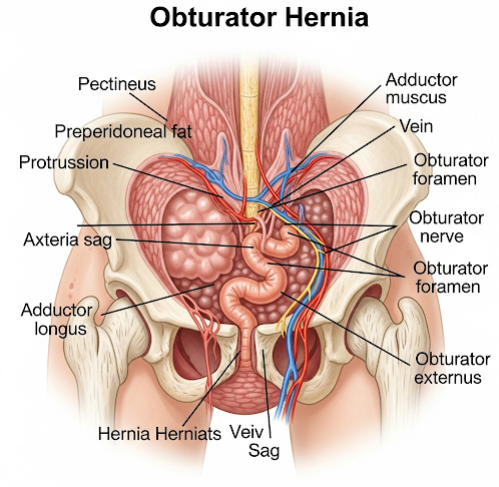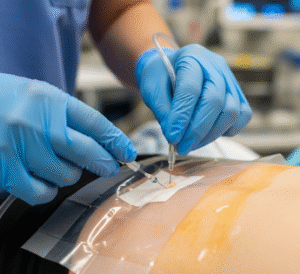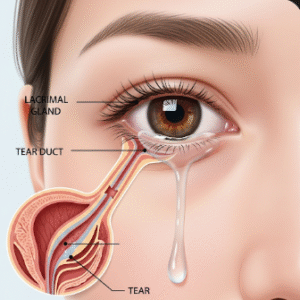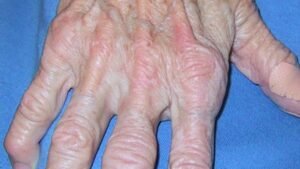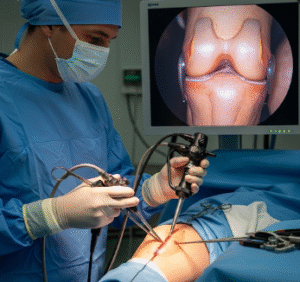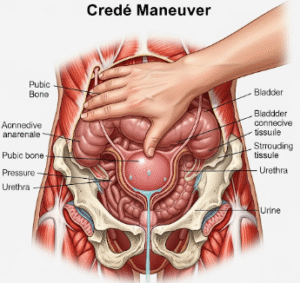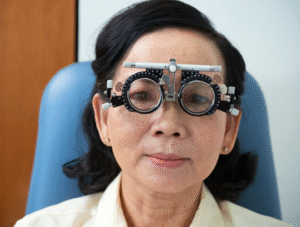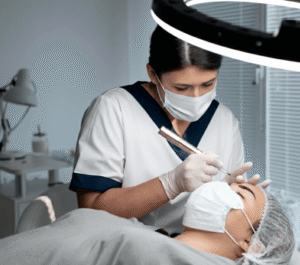Overview
Obturator hernia is a rare but potentially life-threatening condition where part of the intestine or other abdominal tissue protrudes through the obturator canal, a small opening in the pelvic bone. This hernia often leads to bowel obstruction and is commonly diagnosed late because it presents with non-specific symptoms, making early recognition challenging. Obturator hernias are most frequently seen in elderly, thin women, especially those who have experienced significant weight loss or multiple pregnancies. Due to the deep location of the hernia, a physical bulge is usually not visible, and diagnosis often requires imaging or surgical exploration.
What is Obturator Hernia?
An obturator hernia occurs when abdominal contents—typically a loop of the small intestine—pass through the obturator foramen, which is located between the ischium and pubis bones in the pelvis. This hernia may compress the obturator nerve, leading to a characteristic symptom known as the Howship-Romberg sign: pain in the inner thigh, especially when moving the leg. Obturator hernias often result in intestinal obstruction, and since diagnosis is frequently delayed, they have a high mortality rate if not treated promptly.
Symptoms
The symptoms of an obturator hernia are often vague and can resemble other conditions, which is why early diagnosis is difficult. Common signs include:
- Lower abdominal or pelvic pain
- Inner thigh pain (due to obturator nerve compression)
- Pain worsens with leg movement, coughing, or stretching
- Nausea and vomiting
- Abdominal distension
- Constipation or inability to pass gas
- Signs of bowel obstruction, such as cramping and bloating
- Howship-Romberg sign: pain radiating down the thigh, often mistaken for hip or spine problems
Because of its deep location, there is rarely a visible bulge, unlike other types of hernias.
Causes
Obturator hernias are typically caused by weakness in the pelvic floor or increased intra-abdominal pressure. Specific causes and risk factors include:
- Loss of protective fat tissue in the pelvis
- Multiple pregnancies, which stretch and weaken pelvic structures
- Chronic constipation or straining
- Ascites (fluid in the abdomen)
- Chronic cough or heavy lifting
- Aging, leading to natural tissue atrophy
- Previous abdominal surgery or trauma
Risk Factors
Individuals more likely to develop an obturator hernia include:
- Elderly women (especially those over 70)
- People with low body weight or recent significant weight loss
- Patients with a history of multiple deliveries
- Individuals with chronic illnesses, such as COPD or ascites
- Patients with malnutrition or cachexia
The condition is rare in men and younger individuals.
Complications
If left untreated, obturator hernias can result in:
- Bowel obstruction
- Strangulated hernia: Blood supply to the trapped bowel is cut off, causing tissue death
- Perforation of the intestine
- Peritonitis: A life-threatening infection of the abdominal lining
- Sepsis and shock
- High mortality rate, especially if diagnosis is delayed
Prompt diagnosis and surgical intervention are critical to prevent these serious outcomes.
Prevention
While obturator hernias are not entirely preventable, some strategies may help reduce the risk:
- Maintaining a healthy weight and avoiding extreme weight loss
- Managing chronic constipation to reduce straining
- Treating chronic coughs and respiratory disorders
- Pelvic floor strengthening exercises in at-risk individuals
- Monitoring patients who have risk factors, especially elderly women with unexplained abdominal or thigh pain
Treatment Options in Korea
South Korea offers advanced surgical and diagnostic capabilities for rare hernias like the obturator hernia. Management usually involves emergency surgery due to the high risk of complications.
1. Diagnosis
- CT scan of the abdomen and pelvis: Most effective imaging tool
- Ultrasound or MRI: May aid in diagnosis, especially in thin patients
- Physical examination: Often limited; diagnosis is typically confirmed radiologically or during surgery
- Howship-Romberg sign: Clinical clue in thin elderly women with thigh pain and intestinal symptoms
2. Surgical Treatment
- Emergency laparotomy or laparoscopy: To relieve bowel obstruction and repair the hernia
- Bowel resection: May be needed if the intestine is strangulated or necrotic
- Hernia repair using mesh or suture techniques to reinforce the pelvic floor
- Laparoscopic repair: Minimally invasive and increasingly preferred, especially in elective cases
3. Postoperative Care
- Monitoring for infection, recurrence, and bowel function recovery
- Pain management and mobility support
- Nutritional rehabilitation in patients with poor baseline status
4. Leading Hospitals in Korea for Hernia Repair
- Asan Medical Center – Department of General Surgery
- Samsung Medical Center – Advanced Gastrointestinal Surgery Unit
- Seoul National University Hospital – Emergency and GI Surgery Division
- Severance Hospital (Yonsei University) – Laparoscopic Surgery Center
- Korea University Guro Hospital – Hernia and Abdominal Wall Center
These institutions offer:
- 24/7 emergency surgery teams
- Advanced imaging and diagnostic support
- Minimally invasive surgical techniques
- Multilingual services for international patients

